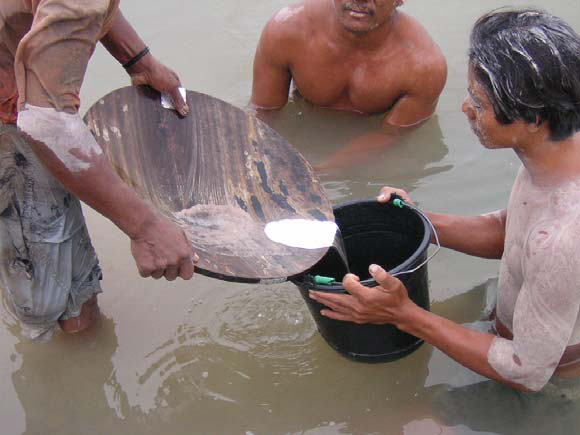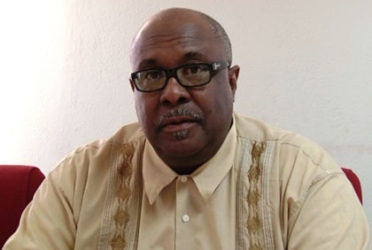As the Guyana Geology and Mines Commission (GGMC) continues to pursue the goal of achieving reduced mercury use in mining, Commissioner Newell Dennison has signaled that complete eradication of the chemical in local mining activities may not be possible.
Dennison told Sunday Stabroek that many artisanal miners are unable to access financing to transition into mercury-free mining. This means that the use of the chemical will always be seen as the most profitable means of extracting gold.
On the other hands, those miners whom he described as ‘mechanised,’ are able to adopt the non-mercury methods that are available as it would be cost effective for them.

“As long as there is room for trade, eradication will only be as good as our ability to regulate,” the Dennison pointed out.
Guyana is a signatory to the Minamata Convention, which is aimed at reducing and eliminating the use of mercury in gold production.
A flyover of any gold mining district across the country illustrates the damaging environmental effects of gold mining operations.
And while it is unclear how much mercury is being used in Guyana to extract gold, communities in the hinterland have complained and raised concerns about the presence of mercury pollution in the waterways, which they are reliant on for drinking and domestic purposes.
The anthropogenic effects of mercury have long been of concern. With its use largely unregulated, its entering into the environment and accumulation up the food chain, where it can cause a range of negative impacts on ecosystems and humans, have seen growing global efforts to curtail its use.
Since Guyana became a signatory to the convention, some work has been done to achieve the objectives.
However, Dennison disclosed that there are some challenges in achieving the objectives as there are persons who believe that the convention calls for the complete eradication of mercury while others are saying that it is calling for reduction. GGMC recognises that the idea is reduction.
Executive Director of the Environmental Protection Agency (EPA) Kemraj Parsram agrees, saying that the goal of the convention is to reduce mercury usage in small- and medium-scale mining and to eliminate the bad practices that harm the environment and human health, which is similar to what Guyana’s National Action Plan will include.
The GGMC Commissioner disclosed that his agency has played an active role in contributing to the development of the National Action Plan, which is still being formulated. While unable to say what the current stage of the draft is, Dennison said it is “well progressed.”
A buy-in challenge
During a forum, “Transitioning to Mercury Free Mining,” organised by the Georgetown Cham-ber of Commerce and Industry earlier this year, Chairman of the GGMC board, Jimmy Reece, pointed out that it has been challenging to convince miners to invest in new eco-friendly technologies.
He pointed out that while miners are focused on profitability, their investments are always budget-oriented. This, he said, makes it difficult to change their mindset from investing in technologies that are new and might not give the output they are accustomed to.
“Buy-ins are the biggest challenges and financing options prevent this buy-in from local miners. They look at cash flow and revenue, they break it down like any investment and try to capitalise and move to the next stage to be able to be financially stable… but many miners are not breaking even, these are real challenges…” he explained during the forum.
As the government continues to push ahead the agenda for the transition of mercury-free mining, Reece stated that incentives and financing options should be considered to encourage buy-in from miners. He also stated that technologies should be patented to the Guyanese market to make the buy-in more feasible and profitable for miners.
Further, he explained that the alternative technologies being looked at do not target the complete eradication of mercury, but more so to reduce mercury use and emissions.
According to him, the National Action Plan for achieving objectives set out in the Minamata Convention is scheduled to be completed this year and will outline timeframes and timelines for mercury reduction and essentially mercury-free mining.
Asked if he believes that Guyana stands a chance of eliminating mercury from mining practices by 2025, Reese responded in his personal capacity and said no. Nonetheless, he believes that reduction is possible if incentives are offered and miners change their traditional practices.
Guyana Gold and Diamond Miners Association (GGDMA) executive Hilbert Shields opined at the same forum that in order to achieve an easy transition into mercury reduction or mercury-free mining, there must be alternatives readily available for small miners. He opined that technologies must be introduced to miners to aid in the reduction and elimination of mercury mining, and suggested the government should consider having alternatives available before moving forward with any agenda of complete elimination.
Shields’ opinion was that miners are accustomed to traditional practices, which make it somewhat difficult for new technology to be adopted in the industry. Nonetheless, there must be options available for easy buy-ins.
He added that there is no need for mercury to be used in the sluice box extraction method of gold during the primary and secondary processing phase, since it does not have any technical benefits.
Dennison stated that the Commission has been continuously working with the relevant agencies to promote the use of other gold recovery methods and has recently collaborated with the GGDMA and the Guyana Women Miners Organisation (GWMO) to research and investigate non-mercury processor plants.
Touching on some small accomplishments as they work toward reducing heavy mercury mining, he said there has been some amount of success and the collaborating agencies have since partnered to import that plant to conduct a trial-run. If this works, they would likely head in this direction in a first step to make mining more sustainable. Further, the promotion of non-mercury processors has been GGMC’s highest priority especially in the large mining areas.
GGMC has since implemented a system aimed at controlling the quantity of mercury being imported into the country. And to further control the mercury mining environment, in collaboration with the Ministry of Natural Resources, the Environmental Protection Agency, and the Pesticides and Toxic Chemical Control Board, GGMC has been implementing various strategies to reduce the importation of mercury in keeping with the terms of the convention.
Dennison explained that they are trying to be stricter with the importation of mercury. As it is now, he said, only a certain amount of mercury is being allowed in the country. “We have put a cap on how much mercury one person can bring into the country in a year,” the Commissioner informed.
Additionally, they also keep records of who the consumers are and where it is being sold, and importers are required to train persons to handle and store the chemical. This initiative, he said, is working quite well and has seen some accountability in that area of operations.
Mercury importation under the regulations has been capped at 1,000 flasks or 34,500 kilogrammes per year. Importers are allowed to import a maximum of 150 flasks of mercury at any one time. The move is seen as one that supports Guyana’s commitment to eliminating and reducing mercury mining.
‘A healthy state’
Meanwhile, GGMC has been active in trying to assist miners and help them with processes that will improve their methodologies and improve their footprint.
“In a general sense, even with the unfortunate situation we have had in the last year or two, I think the sector is in a fairly healthy state. We can’t diminish that we don’t have issues and GGMC can do better,” he said, adding that they are working with young and new miners and that there are very simple ways that you can do mining.”
While the GGMC is taking the lead on reducing mercury usage in gold mining, Parsram stated that the EPA will provide the necessary support to ensure that practices are improved. He noted that the agency is also involved in education and awareness campaigns on good mining practices. Based on these exercises, he said, the EPA has recognised that miners are eager to improve mining practices and have expressed willingness to adopt alternative methods to extract gold.
However, with limited information available to the miners on those methods, miners are skeptical about those processes especially as it relates to gold recovery. He posited that if more information can be made available, there will no doubt be some changes.
Parsram also disclosed that the EPA has also been responding to complaints of pollution and bad mining practices in communities across the country and the agency has investigated those matters alongside GGMC.
Asked whether the EPA is aware of any areas of concern, Parsram responded that there is no significant mercury impact in Guyana, but there are several areas in the mining regions that are being monitored. However, there needs to be more detailed assessments done to determine which communities are heavily at risk. He noted that there is the issue of background mercury, explaining that the chemical does not always directly relate to mining as it occurs naturally as well.
In addition to this, Conservation International, in partnership with the government has been working to eradicate mercury use in mining under the planetGOLD- Guyana initiative.
According to the programme website, they are aiming at achieving 100% percent of mercury free mining.
“By directly involving business enterprises and creating market incentives, the project is utilizing a profit motive to lead the shift toward a mercury-free ASGM commodity chain, with responsibly mined “El Dorado Gold” branded jewelry as the end product,” the website states.
In a bid to achieve this goal, key strategies such as creating financial mechanisms for investing in new technologies, establishing mercury-free mining processes, bringing responsibly mined mercury-free gold to market, developing national policies and incentives for producing mercury-free gold, and educating and raising awareness, are being employed.
According to Dennison, there are quite a few miners who have fully transitioned from mercury use in mining.





